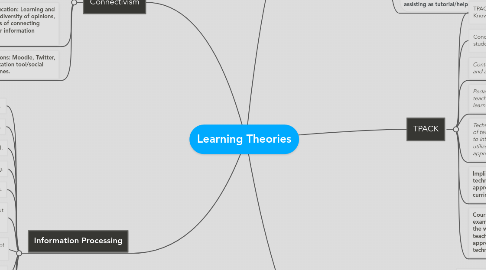Learning Theories
作者:Kristin Marceau

1. Connectivism
1.1. Learning is creating connections and developing a network.
1.2. "A learning theory for the digital age."
1.3. Knowing more is critical than what is currently known.
1.4. Implications for education: Learning and knowledge rests in diversity of opinions, learning is a process of connecting specialized nodes or information sources.
1.5. Course concept connections: Moodle, Twitter, Facebook (any communication tool/social networking), search engines.
2. Information Processing
2.1. Related to Behaviourism.
2.2. Learning is active, not passive.
2.3. Role of attention/role of rehearsal.
2.4. Observable behaviour does not equal learning.
2.5. The concept that learning is a mental process.
2.6. Learning itself is not directly observable, but rather an active process of remembering, acquiring and using knowledge.
2.7. Learning = change of knowledge = change of behaviour.
2.8. The belief that the mind acts like a computer.
2.9. Stimulus --> input --> storage --> output --> response.
2.10. Implications for education: Teacher centred learning (ex: Never Eat Shredded Wheat for the directions of North, East, South and West), chunking.
2.11. Course concept connections: Mind Map, Eportfolio (making ideas and reviewing), note taking (electronic or on paper).
3. Behaviorism
3.1. Environmental stimulus + a blank state mind = learning.
3.2. Learner viewed as passive.
3.3. An example of this would be classical conditioning and the example of Pavlov's dog. Pavlov conditioned the dog to salivate when the bell was rang, indicating that food was coming.
3.4. Stimulus = response.
3.5. Behaviour is shaped by positive and negative reinforcement. Positive is adding something, negative is taking it away. However, it is important to know that punishment is NOT negative reinforcement.
3.6. Practice makes perfect.
3.7. Implications for education: Practice makes perfect, teacher directed, observable and measurable learning outcomes, accomplishments with appropriate feedback.
3.8. Course concept connections: Math Blaster (a computer based game that enhances learning), tutorial aids and computer assisting as tutorial/help aids
4. TPACK
4.1. TPACK - Technology Pedagogy Content Knowledge.
4.2. Conditions that a teacher would use to instruct students.
4.3. Content Knowledge: A teacher is familiar with and able to instruct.
4.4. Pedagogical Knowledge: Basic knowledge of teaching approaches such as different learning theories/assessment.
4.5. Technology Knowledge: Using the knowledge of technology such as computers and tablets to integrate into the classroom and how to utilize the technology in a proper and appropriate way.
4.6. Implications for education: Integrating technology into the classroom in the appropriate ways according to the Alberta curriculum.
4.7. Course concept connections: The Gizmo examples that were used in class and the whole EDU210 curriculum that teaches the students how to appropriately and effectively use technology in the classroom.
5. Constuctivism
5.1. Learning is building connections by actively interacting with the environment.
5.2. Begin with complex problems and teach basic skills while problem solving.
5.3. Learning is involved with one's own knowledge from one's own experiences.
5.4. Vygotsky's Zone of Proximal Development.
5.5. Teacher as facilitator, problem/project based learning, authentic tasks.
5.6. Discovery, case-based, collaborative and active learning.
5.7. "Learning is the most effective when learners create tangible, real-world objects."
5.8. Implications for education: Teachers present the problem, students solve it.
5.9. Course concept connections: Allow students to try and think for themselves while solving a problem, opposed to receiving the answer and having a teacher do it for them.


